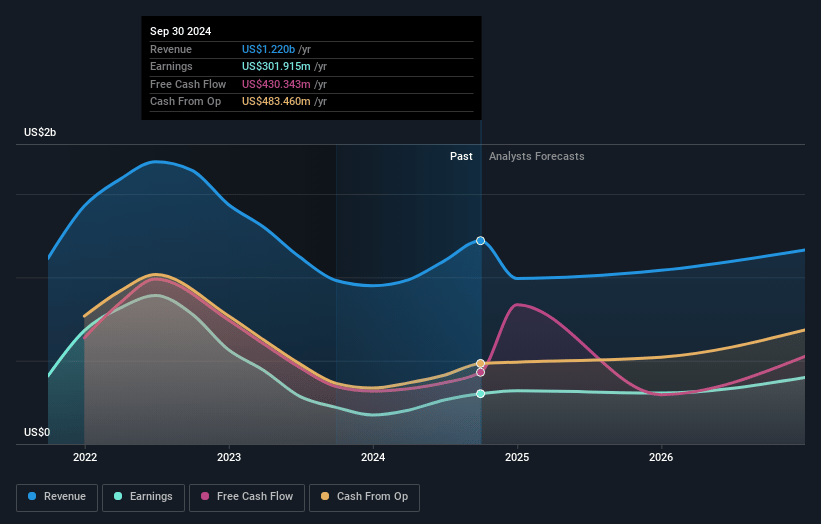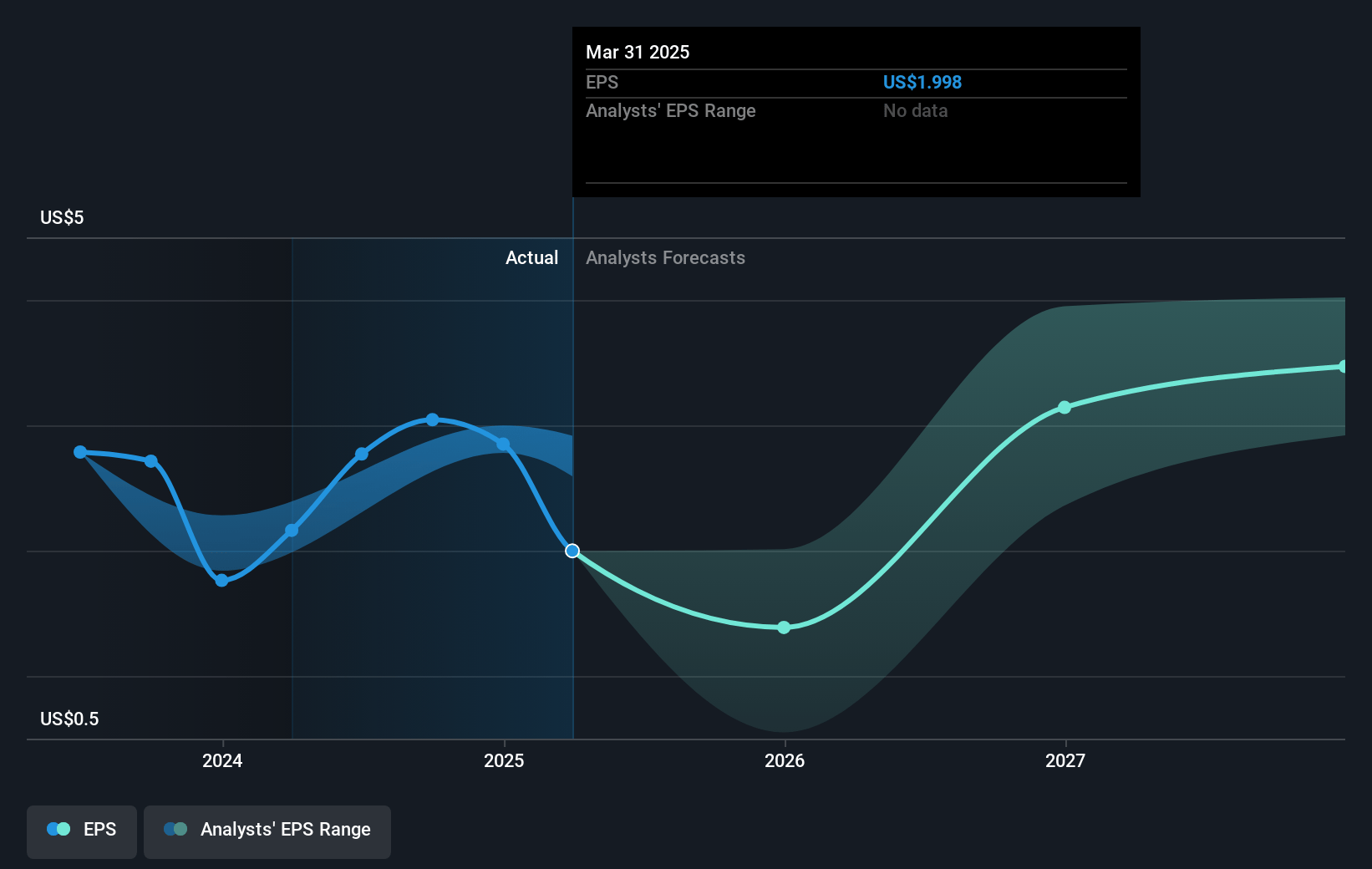Key Takeaways
- Strategic investments in fleet modernization and energy efficiency aim to enhance revenue potential and margins by improving operational capabilities and regulatory compliance.
- A balanced capital allocation policy could boost earnings per share through share buybacks while promoting growth through dividends and fleet renewal.
- High debt, operational costs, and volatile global trade pose financial risks, potentially squeezing margins and impacting Star Bulk Carriers' revenue and earnings.
Catalysts
About Star Bulk Carriers- A shipping company, engages in the ocean transportation of dry bulk cargoes worldwide.
- The integration of Eagle Bulk has generated synergies and operational efficiencies ahead of schedule, with an annualized synergy run rate of $50 million, which is expected to improve net margins and earnings.
- The company is taking advantage of a slow market by front-loading dry dockings, expecting to have 1,640 off-hire days in 2025, which should optimize operational efficiency and potentially enhance future revenue once the market rebounds.
- Star Bulk is investing in energy-saving devices and fleet upgrades to align with environmental regulations (EEXI and CII), which are projected to reduce operating expenses and improve earnings margins.
- The new capital allocation policy, which splits 60% of excess cash flow towards dividends and 40% towards share buybacks, fleet renewal, and growth initiatives, is likely to enhance earnings per share (EPS) through share repurchases and a focus on growth.
- The fleet renewal program, including the sale of non-eco vessels and new Kamsarmax vessels expected in late 2025 and early 2026, aims to modernize the fleet, potentially boosting revenue through heightened commercial attractiveness and operational efficiency.
Star Bulk Carriers Future Earnings and Revenue Growth
Assumptions
How have these above catalysts been quantified?- Analysts are assuming Star Bulk Carriers's revenue will decrease by 1.5% annually over the next 3 years.
- Analysts assume that profit margins will increase from 24.1% today to 41.0% in 3 years time.
- Analysts expect earnings to reach $497.0 million (and earnings per share of $4.24) by about March 2028, up from $304.7 million today. The analysts are largely in agreement about this estimate.
- In order for the above numbers to justify the analysts price target, the company would need to trade at a PE ratio of 7.9x on those 2028 earnings, up from 6.2x today. This future PE is greater than the current PE for the US Shipping industry at 4.3x.
- Analysts expect the number of shares outstanding to grow by 2.91% per year for the next 3 years.
- To value all of this in today's terms, we will use a discount rate of 11.72%, as per the Simply Wall St company report.
Star Bulk Carriers Future Earnings Per Share Growth
Risks
What could happen that would invalidate this narrative?- The company's substantial debt level of $1.3 billion relative to its cash position could pose a financial risk, potentially impacting net margins if earnings do not meet expectations or if interest rates increase significantly.
- The dry dock expenses, estimated at $68 million with 53 vessels expected to be docked, could lead to significant operational downtime (off-hire days), adversely affecting revenue and impacting overall earnings.
- The projected slowdown in dry bulk demand growth, particularly with China's imports expected to decelerate, may negatively impact revenue if trade volumes do not meet expectations.
- Increased operational costs due to fleet renewal, compliance with environmental regulations (like EEXI and CII), and retrofitting vessels for energy efficiency could squeeze net margins if not offset by higher freight rates.
- The potential volatility in global trade patterns, especially due to geopolitical uncertainties such as trade wars and protectionist policies, could affect Star Bulk’s revenue through ton-mile disruptions and shifts in trade routes.
Valuation
How have all the factors above been brought together to estimate a fair value?- The analysts have a consensus price target of $22.24 for Star Bulk Carriers based on their expectations of its future earnings growth, profit margins and other risk factors. However, there is a degree of disagreement amongst analysts, with the most bullish reporting a price target of $36.88, and the most bearish reporting a price target of just $15.8.
- In order for you to agree with the analyst's consensus, you'd need to believe that by 2028, revenues will be $1.2 billion, earnings will come to $497.0 million, and it would be trading on a PE ratio of 7.9x, assuming you use a discount rate of 11.7%.
- Given the current share price of $16.2, the analyst price target of $22.24 is 27.1% higher.
- We always encourage you to reach your own conclusions though. So sense check these analyst numbers against your own assumptions and expectations based on your understanding of the business and what you believe is probable.
How well do narratives help inform your perspective?
Disclaimer
Warren A.I. is a tool utilizing a Large Language Model (LLM) that ingests data on consensus price targets, forecasted revenue and earnings figures, as well as the transcripts of earnings calls to produce qualitative analysis. The narratives produced by Warren A.I. are general in nature and are based solely on analyst data and publicly-available material published by the respective companies. These scenarios are not indicative of the company's future performance and are exploratory in nature. Simply Wall St has no position in the company(s) mentioned. Simply Wall St may provide the securities issuer or related entities with website advertising services for a fee, on an arm's length basis. These relationships have no impact on the way we conduct our business, the content we host, or how our content is served to users. The price targets and estimates used are consensus data, and do not constitute a recommendation to buy or sell any stock, and they do not take account of your objectives, or your financial situation. Note that Warren A.I.'s analysis may not factor in the latest price-sensitive company announcements or qualitative material.




